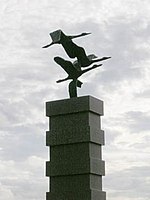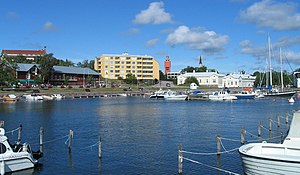Hanko
| Hanko Hanko – Hangö | |||
|---|---|---|---|
| — Municipality and town — | |||
| Hangon kaupunki – Hangö stad | |||
| Eastern Harbour coastline | |||
| |||
| Location of Hanko in Finland | |||
| Coordinates: 59°50′N 022°58′E / 59.833°N 22.967°ECoordinates: 59°50′N 022°58′E / 59.833°N 22.967°E | |||
| Country | Finland | ||
| Region | Uusimaa | ||
| Sub-region | Raseborg sub-region | ||
| Charter | 1874 | ||
| Government | |||
| - Town manager | Jouko Mäkinen | ||
| Area(2010-01-01)[1] | |||
| - Total | 800.22 km2 (309 sq mi) | ||
| - Land | 116.9 km2 (45.1 sq mi) | ||
| - Water | 683.32 km2 (263.8 sq mi) | ||
| Area rank | 143rd largest in Finland | ||
| Population (2010-10-31)[2] | |||
| - Total | 9,486 | ||
| - Rank | 107th largest in Finland | ||
| - Density | 81.15/km2 (210.2/sq mi) | ||
| Population by native language[3] | |||
| - Finnish | 53.5% (official) | ||
| - Swedish | 43.7% (official) | ||
| - Others | 2.9% | ||
| Population by age[4] | |||
| - 0 to 14 | 15.2% | ||
| - 15 to 64 | 65.4% | ||
| - 65 or older | 19.4% | ||
| Time zone | EET (UTC+2) | ||
| - Summer (DST) | EEST (UTC+3) | ||
| Municipal tax rate[5] | 20.75% | ||
| Website | www.hanko.fi | ||
Hanko (Finnish pronunciation: [ˈhɑŋko]; Swedish: Hangö), is a bilingual port town and municipality on the south coast of Finland, 130 kilometres (80 mi) west of Helsinki. Its current population is 9,486 (31 October 2010),[2] with a majority being Finnish speakers and a strong minority being (44%) Swedish speakers.[3]
Contents |
Features
The Hanko Peninsula, on which the city is located, is the southernmost tip of continental Finland. The soil is a sandy moraine, and vegetation consists mainly of pine and low shrubs. Hanko is known for its beautiful archipelago.
The city has a coastline of approximately 130 km (80 mi), of which 30 km (20 mi) are sandy beaches. There are also over 90 small islands and islets within the city limits.
The skyline of Hanko is dominated by the church and the water tower. Both of them received their current appearance after World War II, as their predecessors were either damaged or destroyed by the Soviet Armed Forces.
Scandlines serve the link between Hanko and Rostock since October 2007 four times a week with two RoRo-vessel. The trip takes some 36 hours.
Events
The Hangon Regatta has been a traditional fixture on the Finnish social scene, and is the major summer event in Hanko. Sailing enthusiasts attend in order to compete, as well as mostly young people who have little or no interest in sailing; they attend only in order to party and drink. The latter constitute the "Regatta tail", not appreciated by most of the town's residents, since it causes huge expenses for clean-up of the parks and streets of all the litter left by those partying.
Other traditional summer activities are the "Tennis Week", the "Sea Horse" riding competitions, and the "Summer Theatre" events.
Several sandy beaches and a multitude of leisure harbors attract tourists during the summer months.
History

This file has an uncertain copyright status and may be deleted. You can comment on its removal.
The site was already known by sailors in the 15th century. Petroglyphs from that time are carved into the rock at the Hauensuoli (Swedish: Gäddtarmen, English: Pike's Gut) island.
Hanko has a long history of wars and battles. The Battle of Gangut between Swedish and RussianRussian regular fleet. navies was fought in 1714 in the archipelago north of the peninsula. The battle was the first-ever victory of the
The fortification works on the Hanko Peninsula had already been started by the end of the 18th century, when the Swedish constructed three separate forts on the outlying islands. The forts were later bombarded by the Royal Navy during the Crimean War and they were eventually blown up during the hostilities by their own defenders.
The city was founded in 1874, soon after the Hanko-Hyvinkää railway was inaugurated in 1872. The Imperial Charter for the city was granted by Tsar Alexander II.
Hanko was the port of choice for emigrants leaving Finland for a new life in North America in the late 19th and early 20th centuries. A memorial statue, showing birds in flight, commemorates this.
In the late 19th century, while Finland was still a Grand Duchy under Russia, Hanko was a popular spa resort for the Russian nobility. Some of the buildings from that period survive, notably the Hanko Casino (which is not a gambling establishment, but a former banquet hall of the spa). It is nowadays a restaurant.
Field Marshal C. G. Mannerheim owned a café, Neljän Tuulen Tupa ("The House of the Four Winds") which still is very popular among tourists and residents alike.
The Bengtskär lighthouse is the highest one (52 m/171 ft) in the Nordic countries. It is situated 25 km (16 mi) southwest of Hanko. It was built in 1906 and it is the first lighthouse museum in Finland.

In the Moscow Peace Treaty that ended the Winter War on March 13, 1940, Hanko was leasedSoviet Union as a military base for a period of 30 years. During the Continuation War, Soviet troops were forced to evacuate Hanko in early December 1941. The Soviet Union renounced the lease formally in the Paris peace treaty of 1947. As a curiosity, it can be noted that the short Russo-Finnish front across the base of the peninsula on the Finnish side was held in part by volunteer troops from Sweden. A museum has been established at this location, among the trenches and other remnants of the war. to the
The role of the Hanko naval base was replaced by Porkkala in the armistice between Finland and the Soviet Union of September 19, 1944, released back to Finland in January 1956.
Sports
The following sports clubs are located in Hanko:






Ei kommentteja:
Lähetä kommentti